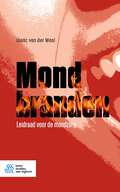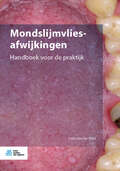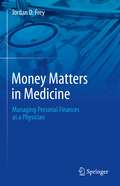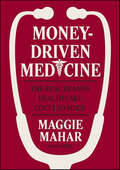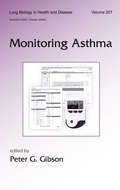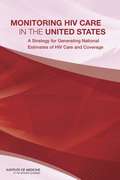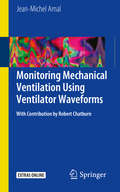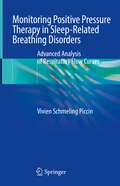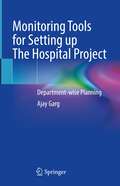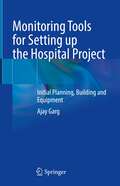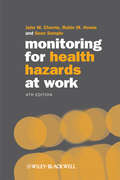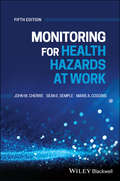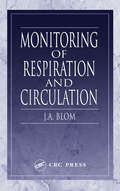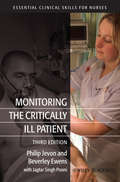- Table View
- List View
Mondbranden: Leidraad voor de mondzorg
by Isaäc van der WaalDit boek is bedoeld als leidraad voor tandheelkundige en medische gezondheidswerkers in de eerste- en tweede lijn bij de behandeling en begeleiding van patiënten, die lijden aan het relatief zeldzame, maar onaangename fenomeen van mondbranden. De tekst berust deels op literatuurgegevens, maar vooral op ruime praktijkervaring van de auteur. Hoewel de oorzaak van mondbranden onbekend is en de behandeling derhalve alleen symptomatisch van aard kan zijn, is het toch vaak mogelijk om een voor veel patiënten bijna ondraaglijke aandoening tot een aanvaardbaar niveau terug te brengen.
Mondfuncties en sensomotoriek
by R. Bastiaanse P.H.O. Dejonckere K. Jansonius-Schultheiss B.J.E. Mondelaers H.F.M. Peters J. Van Borsel Sj. Van der MeulenHet Handboek Stem-Spraak-Taalpathologie verscheen tussen 1997 en 2007 gefaseerd in losse afleveringen. Daarin werd alle kennis op het gebied van de stem-, spraak- en taalpathologie vanuit verschillende disciplines samengebracht. Het Handboek is bestemd voor iedereen die klinisch-praktisch of meer theoretisch is geïnteresseerd, of vanuit een ander vakgebied hiermee in aanraking komt. Voor logopedisten, artsen, linguïsten, spraak- en taalpathologen, audiologen, pedagogen en psychologen in Nederland en België is het Handboek een onmisbare vraagbaak.Deel 4 omvat kennis over de normale ontwikkeling van schedel, gelaat en gezicht en kennis over de normale ontwikkeling van orale sensomotoriek en mondfuncties. Problemen kunnen alleen worden begrepen als ze worden gerelateerd aan een normaal patroon van ontwikkeling en groei.
Mondslijmvliesafwijkingen: Handboek voor de praktijk
by Isaäc van der WaalDit boek geeft een helder overzicht van de diagnostiek en behandeling van veelvoorkomende mondslijmvliesafwijkingen. Het is bedoeld voor gebruik in de dagelijkse praktijk, maar is ook zeer geschikt als naslagwerk. Het richt zich op een breed scala aan gezondheidsprofessionals, zoals mondhygiënisten, tandartsen, mond-, kaak- en aangezichtschirurgen, dermatologen en keel-, neus- en oorartsen. Mondslijmvliesafwijkingen, handboek voor de praktijk is ingedeeld op basis van de klinische presentatie van de afwijkingen. Zo zijn er verschillende hoofdstukken voor overwegend witte, wit-rode en rode afwijkingen. En zijn er hoofdstukken die gewijd zijn aan afwijkingen die zich voordoen op het tandvlees, de tong of de lippen. Het inleidende hoofdstuk gaat in op de vraag wanneer en hoe te verwijzen naar een meer deskundige specialist, en hoe de patiënt daarin betrokken kan worden. Isaäc van der Waal werd in 1979 hoogleraar in de Orale Pathologie aan de Vrije Universiteit. Van 1989 tot 2011 was hij hoofd van de afdeling Mondziekten, Kaak- en Aangezichtschirurgie van het VUmc/ACTA. Hij droeg bij aan ruim 400 wetenschappelijke publicaties en schreef verschillende leerboeken en atlassen op het gebied van mond- en kaakaandoeningen.
Money Matters in Medicine: Managing Personal Finances as a Physician
by Jordan D. FreyThis book addresses both the philosophical and more tangible actionable components of attaining financial well-being as a medical professional. In an engaging, narrative-driven format, it relays the importance of managing one’s finances—even with the high salary of a doctor. Money Matters in Medicine is an accessible, invaluable resource for early-career physicians who wish to incorporate intelligent money management skills in their development as medical professionals. Chapters include information on becoming financially literate, how to approach insurance, creating a savings rate, and the top mistakes most doctors make with their money. Though there are many financial self-help books in the market, this book stands out, as it rests on philosophies and core standards held by those in the medical community. It presents the strategies to promote financial well-being and ultimately help doctors become more effective physicians with financial freedom. The book includes easy-to-understand guidelines and intuitive steps for readers to take massive action in their lives to improve their financial well-being.
Money-Driven Medicine: The Real Reason Health Care Costs So Much
by Maggie MaharWhy is medical care in the United States so expensive? For decades, Americans have taken it as a matter of faith that we spend more because we have the best health care system in the world. But as costs levitate, that argument becomes more difficult to make. Today, we spend twice as much as Japan on health care—yet few would argue that our health care system is twice as good.Instead, startling new evidence suggests that one out of every three of our health care dollars is squandered on unnecessary or redundant tests; unproven, sometimes unwanted procedures; and overpriced drugs and devices that, too often, are no better than the less expensive products they have replaced.How did this happen? In Money-Driven Medicine, Maggie Mahar takes the reader behind the scenes of a $2 trillion industry to witness how billions of dollars are wasted in a Hobbesian marketplace that pits the industry's players against each other. In remarkably candid interviews, doctors, hospital administrators, patients, health care economists, corporate executives, and Wall Street analysts describe a war of "all against all" that can turn physicians, hospitals, insurers, drugmakers, and device makers into blood rivals. Rather than collaborating, doctors and hospitals compete. Rather than sharing knowledge, drugmakers and device makers divide value. Rather than thinking about long-term collective goals, the imperatives of an impatient marketplace force health care providers to focus on short-term fiscal imperatives. And so investments in untested bleeding-edge medical technologies crowd out investments in information technology that might, in the long run, not only reduce errors but contain costs.In theory, free market competition should tame health care inflation. In fact, Mahar demonstrates, when it comes to medicine, the traditional laws of supply and demand do not apply. Normally, when supply expands, prices fall. But in the health care industry, as the number and variety of drugs, devices, and treatments multiplies, demand rises to absorb the excess, and prices climb. Meanwhile, the perverse incentives of a fee-for-service system reward health care providers for doing more, not less.In this superbly written book, Mahar shows why doctors must take responsibility for the future of our health care industry. Today, she observes, "physicians have been stripped of their standing as professionals: Insurers address them as vendors ('Dear Health Care Provider'), drugmakers and device makers see them as customers (someone you might take to lunch or a strip club), while . . . consumers (aka patients) are encouraged to see their doctors as overpaid retailers. . . . Before patients can reclaim their rightful place as the center—and indeed as the raison d'être—of our health care system," Mahar suggests, "we must once again empower doctors . . . to practice patient-centered medicine—based not on corporate imperatives, doctors' druthers, or even patients' demands," but on the best scientific research available.
MoneyBall Medicine: Thriving in the New Data-Driven Healthcare Market
by Harry Glorikian Malorye Allison BrancaHow can a smartwatch help patients with diabetes manage their disease? Why can’t patients find out prices for surgeries and other procedures before they happen? How can researchers speed up the decade-long process of drug development? How will "Precision Medicine" impact patient care outside of cancer? What can doctors, hospitals, and health systems do to ensure they are maximizing high-value care? How can healthcare entrepreneurs find success in this data-driven market? A revolution is transforming the $10 trillion healthcare landscape, promising greater transparency, improved efficiency, and new ways of delivering care. This new landscape presents tremendous opportunity for those who are ready to embrace the data-driven reality. Having the right data and knowing how to use it will be the key to success in the healthcare market in the future. We are already starting to see the impacts in drug development, precision medicine, and how patients with rare diseases are diagnosed and treated. Startups are launched every week to fill an unmet need and address the current problems in the healthcare system. Digital devices and artificial intelligence are helping doctors do their jobs faster and with more accuracy. MoneyBall Medicine: Thriving in the New Data-Driven Healthcare Market, which includes interviews with dozens of healthcare leaders, describes the business challenges and opportunities arising for those working in one of the most vibrant sectors of the world’s economy. Doctors, hospital administrators, health information technology directors, and entrepreneurs need to adapt to the changes effecting healthcare today in order to succeed in the new, cost-conscious and value-based environment of the future. The authors map out many of the changes taking place, describe how they are impacting everyone from patients to researchers to insurers, and outline some predictions for the healthcare industry in the years to come.
Monique and the Mango Rains: Two Years With A Midwife in Mali
by Kris Holloway John BidwellMonique and the Mango Rains is the compelling story of a rare friendship between a young Peace Corps volunteer and a midwife who became a legend. Monique Dembele saved lives and dispensed hope in a place where childbirth is a life-and-death matter. This book tells of her unquenchable passion to better the lives of women and children in the face of poverty, unhappy marriages, and endless backbreaking work. Monique's buoyant humor and willingness to defy tradition were uniquely hers. In the course of this deeply personal narrative, as readers immerse themselves in the rhythms of West African village life, they come to know Monique as friend, mother, and inspired woman.
Monitoring Asthma
by Peter G. GibsonProviding a solid foundation for specialists in asthma treatment and control, this guide illustrates the importance of asthma monitoring practices for up-to-date assessments of disease levels in specific population groups; the identification of social, geographical, and environmental factors that may influence the development of asthma; and the des
Monitoring Detention, Custody, Torture and Ill-treatment: A Practical Approach to Prevention and Documentation
by Jason Payne-James Jonathan Beynon Duarte VieiraThis landmark practical guide assists all those involved in monitoring detention conditions and investigating and preventing torture. The prestigious global author team identify the medical, legal and professional frameworks and international instruments applicable to those detained, and highlight how torture or other cruel and inhuman degrading treatments or punishments are identified, investigated and should be prevented. · A comprehensive and wide range of detention settings and circumstances are covered including police stations, prisons, mental health, and social care civil conditions to prisoner of war, detention camps, military, and armed conflict. · Advice, monitoring, and assessment is given for special groups, including the custody of women, children, vulnerable adults, and individuals on hunger strike · Practical guidelines are given for the assessment of ill-treatment of individuals in custody including sexual abuse · Online links to the latest legal, ethical, and medical guidelines for key countries help to make this book appropriate for all. Challenging, thought-provoking yet thoroughly practical, this book is essential reading for anyone involved in the monitoring of detention conditions and the treatment and investigation of individuals in any form of custody. The content is aimed primarily at healthcare professionals but it also highly relevant for anyone who may form part of a visiting team, including lay individuals, lawyers and law enforcement professionals, as well as for academics.
Monitoring HIV Care in the United States
by Morgan A. FordThe number of people living with HIV/AIDS (PLWHA) in the United States is growing each year largely due both to advances in treatment that allow HIV-infected individuals to live longer and healthier lives and due to a steady number of new HIV infections each year. The U. S. Centers for Disease Control and Prevention (CDC) estimates that there were 1. 2 million people living with HIV infection in the United States at the end of 2008, the most recent year for which national prevalence data are available. Each year, approximately 16,000 individuals die from AIDS despite overall improvements in survival, and 50,000 individuals become newly infected with HIV. In 2011, the CDC estimated that about three in four people living with diagnosed HIV infection are linked to care within 3 to 4 months of diagnosis and that only half are retained in ongoing care. In the context of the continuing challenges posed by HIV, the White House Office of National AIDS Policy (ONAP) released a National HIV/AIDS Strategy (NHAS) for the United States in July 2010. The primary goals of the NHAS are to: reduce HIV incidence; increase access to care and optimize health outcomes; and reduce HIV-related health disparities. Monitoring HIV Care in the United States addresses existing gaps in the collection, analysis, and integration of data on the care and treatment experiences of PLWHA. This report identifies critical data and indicators related to continuous HIV care and access to supportive services, assesses the impact of the NHAS and the ACA on improvements in HIV care, and identifies public and private data systems that capture the data needed to estimate these indicators. In addition, this report addresses a series of specific questions related to the collection, analysis, and dissemination of such data. Monitoring HIV Care in the United States is the first of two reports to be prepared by this study. In a forthcoming report, also requested by ONAP, the committee will address the broad question of how to obtain national estimates that characterize the health care of people living with HIV in the United States. The second report will include discussion of challenges and best practices from previous large scale and nationally representative studies of PLWHA as well as other populations.
Monitoring HIV Care in the United States: A Strategy for Generating National Estimates of HIV Care and Coverage
by Morgan A. FordIn September 2010, the White House Office of National AIDS Policy commissioned an Institute of Medicine (IOM) committee to respond to a two-part statement of task concerning how to monitor care for people with HIV. The IOM convened a committee of 17 members with expertise in HIV clinical care and supportive services, epidemiology, biostatistics, health policy, and other areas to respond to this task. The committee's first report, Monitoring HIV Care in the United States: Indicators and Data Systems, was released in March 2012. The report identified 14 core indicators of clinical HIV care and mental health, substance abuse, and supportive services for use by the Department of Health and Human Services (HHS) to monitor the impact of the National HIV/AIDS Strategy (NHAS) and the Patient Protection and Affordable Care Act (ACA) on improvements in HIV care and identified sources of data to estimate the indicators. The report also addressed a series of questions related to the collection, analysis, and dissemination of data necessary to estimate the indicators. In this second report, Monitoring HIV Care in the United States: A Strategy for Generating National Estimates of HIV Care and Coverage, the committee addresses how to obtain national estimates that characterize the health care of people with HIV within the context of the ACA, both before 2014 and after 2014, when key provisions of the ACA will be implemented. This report focuses on how to monitor the anticipated changes in health care coverage, service utilization, and quality of care for people with HIV within the context of the ACA.
Monitoring Mechanical Ventilation Using Ventilator Waveforms
by Jean-Michel ArnalThis book discusses the interpretation of mechanical ventilator waveforms. Each page shows a screenshot from a real patient and explains one or two messages. It starts with basic information about the waveforms and goes on to address passive and spontaneous ventilation, non-invasive ventilation and specific measurements such as pressure-volume curves and esophageal pressure. Step by step, readers learn about advanced monitoring of patient-ventilator synchronisation. This unique teaching approach has been adapted to this topic. Covering the entire field of mechanical ventilation, it is of particular interest to physicians and respiratory therapist working in emergency departments, anesthesiology, intensive care and respiratory units.
Monitoring Positive Pressure Therapy in Sleep-Related Breathing Disorders: Advanced Analysis of Respiratory Flow Curves
by Vivien Schmeling PiccinProviding good quality sleep to people with sleep-related breathing disorders is a major challenge for respiratory physiotherapists and other professionals working in the field. These patients chronically suffer from the negative effects of interrupted sleep, a consequence of increased respiratory effort, disturbing arousals and constant hypoxias. Using positive pressure equipment every night goes far beyond simply programming a device and choosing a mask.This book provides a deep analysis and interpretation of the respiratory flow curves during sleep in patients using pressure therapy. It also helps the reader to understand the influence of the physiological and pathophysiological processes on the respiratory pattern during sleep. Consisting of multiples figures, graphics and case examples, this practical work offers a comprehensive and didactic approach to using pressure therapy for sleep apnea treatment. The target audience is Sleep Medicine clinicians, as well as physicians from different specialties (Otolaryngologists, Pulmonologists, Neurologists), Physical Therapists, Dentists, Speech Pathologists, and all other professionals who work with sleep-disordered breathing field.
Monitoring Technologies in Acute Care Environments
by Jesse M. Ehrenfeld Maxime CannessonThis is an introduction to the patient monitoring technologies that are used in today's acute care environments, including the operating room, recovery room, emergency department, intensive care unit, and telemetry floor To a significant extent, day-to-day medical decision-making relies on the information provided by these technologies, yet how they actually work is not always addressed during education and training The editors and contributors are world-renowned experts who specialize in developing, refining, and testing the technology that makes modern-day clinical monitoring possible Their aim in creating the book is to bridge the gap between clinical training and clinical practice with an easy to use and up-to-date guide · How monitoring works in a variety of acute care settings · For any healthcare professional working in an acute care environment · How to apply theoretical knowledge to real patient situations · Hemodynamic, respiratory, neuro-, metabolic, and other forms of monitoring · Information technologies in the acute care setting · New and future technologies
Monitoring Tissue Perfusion in Shock: From Physiology to the Bedside
by Alexandre Augusto Pinto Lima Eliézer SilvaThis book describes various aspects of the basic physiological processes critical to tissue perfusion and cellular oxygenation, including the roles of the circulatory system, respiratory system, blood flow distribution and microcirculation. In the context of monitoring critically ill patients in the early hours of circulatory shock, it is essential to recognize changes in traditional parameters such as mean arterial pressure and cardiac output, and to assess the need for active intervention. However, even if global macrocirculatory variables are restored, abnormalities in tissue oxygenation may persist. Tissue hypoperfusion is connected to the development of organ failure and, if it goes unrecognized, may worsen the prognosis. As a result, there is a growing interest in methods for monitoring regional perfusion in peripheral tissues to predict or diagnose ongoing hypoperfusion. In this work, eminent experts from a range of disciplines convey a working knowledge of how regional monitoring in shock can complement the conventional global parameters of oxygen transport, and demonstrate that real-time bedside assessment of tissue oxygenation is readily achievable using noninvasive monitoring techniques. Accordingly, the book offers a valuable, easy-to-use guide for the entire ICU team and other clinicians.
Monitoring Tools for Setting up The Hospital Project: Department-wise Planning
by Ajay GargCompared to other commercial buildings, hospital buildings are one of the most complex buildings/projects to plan, design, build, and operate. A well-planned set of all the activities involved in construction and setting up the hospital contributes a lot to reducing errors, avoiding modifications, completing a project on time, reducing the modification costs, decreasing or controlling infection rate, protecting patients and staff from injury, increase patient's recovery rate, and increase staff satisfaction. It is a fact that each hospital project department involves many individual departments, providing services, procurement of equipment, workforce recruitment, licensing, and establishing a set of Standard Operating Procedures (SOPs). Apart from this, it is necessary to start the particular activity well on time to make it a success in the scheduled period. If the start of the activity is delayed, it can delay the total project. It is noticed that the site engineer makes a lot of mistakes while setting up the departments. The reason for such mistakes can be like forgetting any particular activity, not completing the activity on time, etc. In this book, we have tried to address all such issues, detailed all the activities in a tabular form, and explained each activity in detail for the individual department of the hospital. The table also contains the columns to plan the start and end date of the activity. The table will also help assess the activity's progress and the person responsible for such activity. The book has been written keeping in mind the timely completion of all the activities involved in setting up and furnishing the hospital's departments. The book contains all such activities right from the initial setting up of the departments to the final inauguration of the hospital. This book is helpful to the designers, promoters, site engineers, architects, and engineers in planning the activity, its start and end, linking it with other activities, monitoring the activity, etc., well in advance. As the book is in very easily understandable English language, it may be a great help to students of Hospital Management, Para Medical Sciences, Architecture, Site Engineers, Site Supervisors, Hospital Promoters, Planners, and Designers.
Monitoring Tools for Setting up the Hospital Project: Initial Planning, Building and Equipment
by Ajay GargThe hospital buildings are one of the most complex buildings/projects to plan, design, build, and operate. Hospital project planning involves site selection, Detailed Project Report (DPR) preparation, feasibility studies, room planning, hospital building zoning, and construction. This book provides in-depth knowledge and synchronization of the operational policies, licensing, services, equipment procurement, workforce recruitment, and establishing the set of Standard Operating Procedures (SOPs) before the start of hospital operations. This book helps enlighten site engineers and various in-charges to plan their hospital projects efficiently, completing all the jobs and activities well in time. This book narrates all the relevant issues and details about the hospital planning and construction activities in a tabular form and explains each activity extensively. Moreover, the tables provided in the book will also help the planners and executors assess the activity's progress and the person responsible for it. The key feature of the book is a very easily understandable English language that provides the best understanding to the students of Hospital Management, Para Medical Sciences, Architecture, Site Engineers, Site Supervisors, Hospital Promoters, Planners, and Designers.
Monitoring and Evaluation in Health and Social Development: Interpretive and Ethnographic Perspectives
by Stephen Bell Peter AggletonNew approaches are needed to monitor and evaluate health and social development. Existing strategies tend to require expensive, time-consuming analytical procedures. The growing emphasis on results-based programming has resulted in evaluation being conducted in order to demonstrate accountability and success, rather than how change takes place, what works and why. The tendency to monitor and evaluate using log frames and their variants closes policy makers’ and practitioners’ eyes to the sometimes unanticipated means by which change takes place.Two recent developments hold the potential to transcend these difficulties and to lead to important changes in the way in which the effects of health and social development programming are understood. First, there is growing interest in ways of monitoring programmes and assessing impact that are more grounded in the realities of practice than many of the ‘results-based’ methods currently utilised. Second, there are calls for the greater use of interpretive and ethnographic methods in programme design, monitoring and evaluation.Responding to these concerns, this book illustrates the potential of interpretative methods to aid understanding and make a difference in real people’s lives. Through a focus on individual and community perspectives, and locally-grounded explanations, the methods explored in this book offer a potentially richer way of assessing the relationships between intent, action and change in health and social development in Africa, Asia, Europe and the Americas.
Monitoring and Intervention for the Critically Ill Small Animal: The Rule of 20
by Andrew Linklater Rebecca KirbyMonitoring and Intervention for the Critically Ill Small Animal: The Rule of 20 offers guidance for assessing the patient, interpreting diagnostic test results, and selecting appropriate monitoring procedures. Based on Rebecca Kirby's time-tested Rule of 20, with a chapter devoted to each item on the checklist Provides comprehensive guidance for monitoring a critically ill small animal patient Emphasizes the interplay of each parameter with one another Designed for fast access on the clinic floor, with potentially life-saving ideas, tips, lists and procedures Presents tables, schematics, algorithms, and drawings for quick reference
Monitoring for Health Hazards at Work
by Sean Semple John Cherrie Robin HowieMonitoring for Health Hazards at Work has become an essential companion for students and professionals in occupational hygiene, offering a concise account of the dangers faced in a wide variety of work environments and giving practical, step-by-step guidance to gauge exposure. It includes: Coverage of most major health hazards: airborne dust, fibres, gases, vapours, noise, radiation, and biological agents Accounts of the latest equipment and techniques required to monitor such hazards Full guidance on how to undertake risk assessments Now thoroughly revised and restructured by an eminent new team of authors, the fourth edition brings this valuable handbook right up to date.
Monitoring for Health Hazards at Work
by Sean Semple John Cherrie Marie CogginsMONITORING FOR HEALTH HAZARDS AT WORK Monitoring for Health Hazards at Work remains the seminal textbook on measuring and controlling the risk of workplace exposure to physical, chemical, and biological hazards. Designed for students studying occupational hygiene and exposure science, this comprehensive and accessible volume provides step-by-step guidance on identifying hazards and quantifying their risks in various workplace environments. Complete with checklists and practical examples, the authors present clear explanations of all types of hazards that can arise in the workplace, including dust, particles, fibrous aerosols, gases, vapours, and bioaerosols.The fifth edition features revised material throughout, and remains an essential resource for students and professionals in occupational hygiene, reflecting global standards and recent developments in monitoring equipment, modelling methods, exposure assessment, and legislation on workplace safety. Several new or substantially revised chapters cover topics such as human biomonitoring, exposure modelling, hazardous substances, physical agents, evaluating ventilation, PPE, and other control measuresUpdated sections discuss the equipment currently available, the importance of risk communication, assessing dermal and inadvertent ingestion exposures, and moreExamines common workplace comfort issues such as noise, vibration, heat and cold, and lightingOffers practical advice on conducting and presenting risk assessments and reportsDiscusses the future of the development and application of hazard measurement equipment and methodsMonitoring for Health Hazards at Work, is required reading for students and professionals in occupational hygiene, environmental health and safety, occupational health and safety, and exposure science.
Monitoring in Anesthesia and Perioperative Care
by David L. Reich James B. Eisenkraft Andrew B. Leibowitz Marc E. Stone Coeditors Ronald A. Kahn Alexander J. C. MittnachtAnesthesiologist and other medical specialists document the current art and science of peri-operative patient monitoring and address the systems-based practice issues that drive the health care industry. Writing for medical students and practitioners, they discuss such topics as medico-legal implications of monitoring, cardiac output and intravascular volume, neurological intra-operative and electro-physiologic monitoring, endocrine testing in the operating room, and post-anesthesia care unit assessment scales. Annotation ©2011 Book News, Inc. , Portland, OR (booknews. com)
Monitoring of Respiration and Circulation
by J. A. BlomMonitoring of Respiration and Circulation provides biomedical engineers with a comprehensive source for understanding the variables of the respiratory and circulatory systems, which indicate how well these systems are functioning. This book covers techniques for measuring the variables, including modeling, medical instrumentation, and signal proces
Monitoring the Critically Ill Patient
by Philip Jevon Jagtar Singh Pooni Beverley EwensMonitoring the Critically Ill Patient is an invaluable, accessible guide to caring for critically ill patients on the general ward. Now fully updated and improved throughout, this well-established and handy reference guide text assumes no prior knowledge and equips students and newly-qualified staff with the clinical skills and knowledge they need to confidently monitor patients at risk, identify key priorities, and provide prompt and effective care.This new edition includes the following five new chapters:Monitoring the critically ill childMonitoring the critically ill pregnant patientMonitoring the patient with infection and related systemic inflammatory responseMonitoring a patient receiving a blood transfusionMonitoring pain
Monitoring the Health of Populations by Tracking Disease Outbreaks: Saving Humanity from the Next Plague (ASA-CRC Series on Statistical Reasoning in Science and Society)
by Steven E Rigdon Ronald D. Fricker, Jr.With COVID-19 sweeping across the globe with near impunity, it is thwarting governments and health organizations efforts to contain it. Not since the 1918 Spanish Flu have citizens of developed countries experienced such a large-scale disease outbreak that is having devastating health and economic impacts. One reason such outbreaks are not more common has been the success of the public health community, including epidemiologists and biostatisticians, in identifying and then mitigating or eliminating the outbreaks. Monitoring the Health of Populations by Tracking Disease Outbreaks: Saving Humanity from the Next Plague is the story of the application of statistics for disease detection and tracking. The work of public health officials often crucially depends on statistical methods to help discern whether an outbreak may be occurring and, if there is sufficient evidence of an outbreak, then to locate and track it. Statisticians also help collect critical information, and they analyze the resulting data to help investigators zero in on a cause for a disease. With the recent outbreaks of diseases such as swine and bird flu, Ebola, and now COVID-19, the role that epidemiologists and biostatisticians play is more important than ever. Features: · Discusses the crucial roles of statistics in early disease detection. · Outlines the concepts and methods of disease surveillance. · Covers surveillance techniques for communicable diseases like Zika and chronic diseases such as cancer. · Gives real world examples of disease investigations including smallpox, syphilis, anthrax, yellow fever, and microcephaly (and its relationship to the Zika virus). Via the process of identifying an outbreak, finding its cause, and developing a plan to prevent its reoccurrence, this book tells the story of how medical and public health professionals use statistics to help mitigate the effects of disease. This book will help readers understand how statisticians and epidemiologists help combat the spread of such diseases in order to improve public health across the world.
